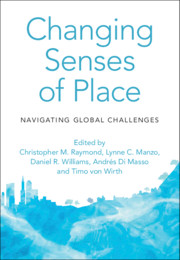Book contents
- Changing Senses of Place
- Changing Senses of Place
- Copyright page
- Dedication
- Contents
- Contributors
- Foreword
- Preface
- Acknowledgements
- Introduction
- Part I Climate Change and Ecological Regime Shifts
- Part II Migration, Mobility and Belonging
- Part III Renewable Energy Transitions
- Part IV Nationalism and Competing Territorial Claims
- Part V Urban Change
- Part VI Technological and Legal Transformations
- 19 Electronically Mediated Sense of Place
- 20 A Dynamic View of Local Knowledge and Epistemic Bonds to Place
- 21 Social Media and Experiences of Nature
- Part VII Design and Planning Strategies for Changing Senses of Place
- Part VIII Conclusion
- Index
- References
21 - Social Media and Experiences of Nature
Towards a Plurality of Senses of Place
from Part VI - Technological and Legal Transformations
Published online by Cambridge University Press: 15 July 2021
- Changing Senses of Place
- Changing Senses of Place
- Copyright page
- Dedication
- Contents
- Contributors
- Foreword
- Preface
- Acknowledgements
- Introduction
- Part I Climate Change and Ecological Regime Shifts
- Part II Migration, Mobility and Belonging
- Part III Renewable Energy Transitions
- Part IV Nationalism and Competing Territorial Claims
- Part V Urban Change
- Part VI Technological and Legal Transformations
- 19 Electronically Mediated Sense of Place
- 20 A Dynamic View of Local Knowledge and Epistemic Bonds to Place
- 21 Social Media and Experiences of Nature
- Part VII Design and Planning Strategies for Changing Senses of Place
- Part VIII Conclusion
- Index
- References
Summary
The chapter focuses on people’s experiences of natural places and changes in their sense of place through the use of social media. It explores how social media are linked to senses of place and experiences of nature from a social–ecological–technological systems perspective. This is illustrated through four empirical cases representing specific people–place–tech systems, i.e. systems where different social, ecological and tech contexts interact. From a system perspective, those couplings are integrated parts of people’s experiences of nature that bridge virtual and physical worlds, thereby facilitating and communicating cognitive, affective and behavioural social-ecological interactions. These interactions foster novel individual and co-constructed meanings of place and thus plural senses of place; they can also mobilise people around shared meanings of place that are used to question dominant views. Thus, it is argued that social media can mediate and proliferate plural meanings of place, leading to new conceptualisations of senses of place.
Keywords
- Type
- Chapter
- Information
- Changing Senses of PlaceNavigating Global Challenges, pp. 271 - 284Publisher: Cambridge University PressPrint publication year: 2021
References
- 4
- Cited by

